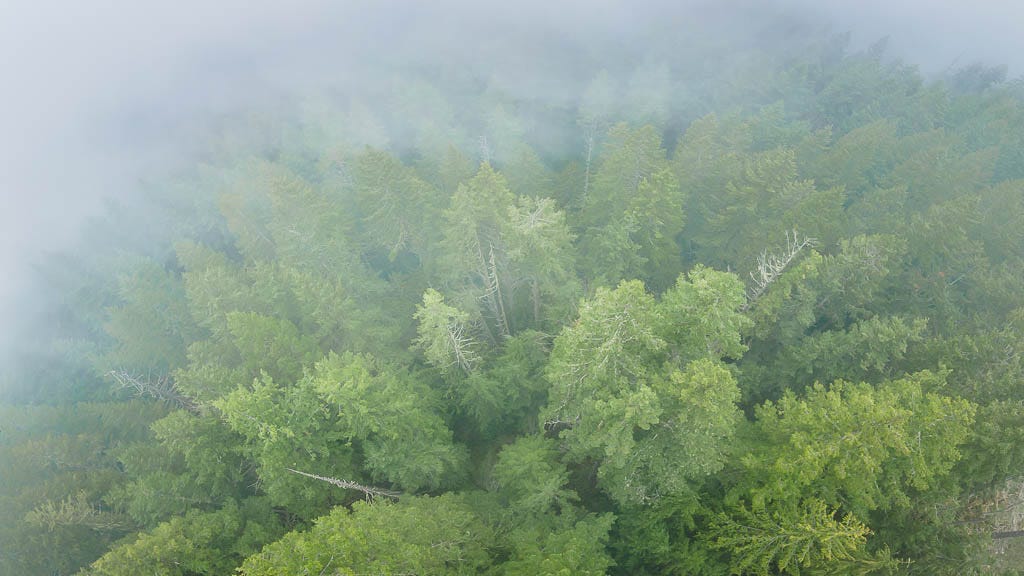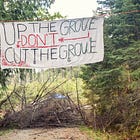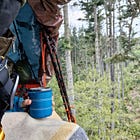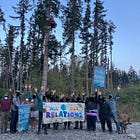Treesit Ends in Likely Victory Despite Attack by Vigilantes
But Washington State just betrayed all their forest protection promises

Welcome to Biocentric, a newsletter about sustainability, overshoot, greenwashing, and resistance. It’s written by me, Max Wilbert, the co-author of Bright Green Lies: How the Environmental Movement Lost Its Way and What We Can Do About It, co-founder of Protect Thacker Pass, and organizer with the Community Legal Environmental Defense Fund.
If you want to follow, you can subscribe for free. Paid subscribers, in return for supporting this publication and the activism you see here, receive access to private posts which contain behind-the-scenes reports and unreleased drafts.
This is a crosspost from the Community Environmental Legal Defense Fund, which has been playing a small role in assisting forest defense actions in Washington State, near where I grew up. I recommend subscribing to CELDF’s Truth and Reckoning Substack to stay updated on the rights of nature movement and other work that I’m involved in through that organization.
Throughout May and June, I brought you updates from a treesit action which was established high in a Douglas fir outside Port Angeles, WA, mobilized to protect a maturing forest from planned logging.
As I wrote at the time:
“Forest defenders launched a blockade this morning in order to halt the clearcut logging of one of the last low-elevation mature forests in the Elwha Watershed. This century-old forest, located on the Olympic Peninsula, is part of the ancestral lands of the S'Klallam people, and it's sale has been the subject of increasing public outcry.
The forest was auctioned last year by the Washington State Department of Natural Resources (DNR), and purchased by the Murphy Company, an Oregon-based timber firm. The timber sale, known as "Parched", is currently under litigation by the Earth Law Center and Legacy Forest Defense Coalition, and a petition—started by members of the Lower Elwha Kallam Tribe urging that the watershed be protected—has been signed by over half of the tribal members, as well as being widely supported by local citizens.
Having never been logged by machinery, this 100-year-old forest is home to Douglas fir, grand fir and western red cedar, and is developing old-growth characteristics essential to endangered species like the northern spotted owl and marbled murrelet. An imperiled flower, whipplea modesta, also makes its home here.
To prevent logging of this critical habitat, forest defenders placed large debris in the middle of the road. This debris is attached to a climber who is suspended above on a “dunk-tank” platform in a large tree. If authorities attempt to remove the road debris, the platform will drop, risking a 100-foot fall for the climber.”
Police raid camp, then armed vigilantes attack
During the ensuing weeks, myself and the community of organizers I worked with tried to support this courageous direct action in every way we could. After sharing several updates from the front lines, and even conducting an interview with the tree sitter, I want to bring you a followup — the story of how the treesit was dismantled, and why — and some cautionary lessons to learn from this action.
On June 13th, police swept the camp that had been established below the treesit, confiscating supplies and temporarily forcing activists — other than the treesitter — to leave. Over the next two days, unknown vigilantes attacked the treesit twice, throwing bottles and aggressively confronting activists.
On the last night of the sit, during the second of these incidents, a vigilante in a black jeep drove up to the site. He brandished a pistol, pointed it at the activists, fired shots into the air, and told forest defenders he was going to “gut them like animals.” The land protectors took shelter as best they could while the man and his female companion attached a winch to the blockade and attempted to pull the treesit platform out of the tree – unsuccessfully. After the attackers left, the treesitter came down in fear for their life. The treesit was dismantled on June 15th, after 40 days.
According to sources on the ground, this took place under total darkness, and amidst the adrenaline and fear, no video was captured of the incident.
Despite the threats of violence and the possibility of loss of human life, there is good news: legacy forest defense activists believe most of the Parched timber sale (the area that was being protected by the treesit) will be protected due to the presence of rare plant communities.
While this isn’t certain, the Washington State Department of Natural Resources has protocols for forests containing rare plant communities, and other timber sales have been halted in similar situations. The rare plant communities were discovered and documented by, among others, my friend Joshua Wright, who has been a leader in the movement.
Units 3a, 3b, 4, 1a, and 1b of the Parched area all contain rare plant communities. Units 1c, 6, and unit 5 unfortunately don’t contain rare plant communities, but according to forest defenders, these units are smaller, contain younger trees, and are generally lower quality habitat than the areas which will likely be protected due to the rare plants.
Washington State just announced a “forest protection plan” that is nothing but greenwashing
As is the case with this forest action and many other campaigns, protecting one area is a success but many others remain vulnerable. The Washington State Department of Natural Resources announced on August 26th that it would protect 77,000 acres of previously vulnerable legacy forests. But not only did the announcement leave huge areas open for logging, it was incredibly misleading.
According to the Washington Legacy Forest Defense Coalition:
“The executive order signed by [Commissioner of Public Lands] Upthegrove does the opposite of what it purports to do, by green-lighting 20 of the 23 timber sales that Upthegrove had pulled back in January of this year, and allowing 29,000 acres of some of the oldest and most structurally complex legacy forests to be clearcut over the next five years. In signing the executive order, Upthegrove in effect adopted the five-year plan developed under the previous Commissioner of Public Lands, which aggressively targets our rapidly disappearing legacy forests for commercial logging.
The Willapa River watershed would be particularly hard hit. Old growth forests have all but disappeared from this watershed, and the 1,000 acres of unprotected legacy forests that remain in the headwaters are some of the oldest and most biologically diverse of any on DNR managed lands in Western Washington. Upthegrove's plan would see 93% of these stands logged over the next five years, leaving just 68 acres of legacy forests protected. A misleading map prepared by DNR suggests that the executive order would result in the protection of 778 acres of structurally complex forest in the Willapa River watershed, but 85% of the acres DNR has mapped as conserved are mapping errors, anomalies, or low conservation value fragments.
… we estimate that the executive order signed by Upthegrove would only conserve between 19,000 to 28,000 acres out of the approximately 92,000 acres of legacy forests that remain unprotected. Even worse, the areas that are conserved under the order are generally small, scattered, and disconnected from other conservation areas, and obviously chosen because they are located in areas that DNR has no plans to harvest.”
This means urgency of action to defend legacy forests on Washington State DNR lands remains over the next half decade. For now, there is no victory. There is only the continuation of the struggle to defend these lands. And the urgency of the struggle is higher than it ever has been under Upthegrove right now.
In this context, direct action, rights of nature-style community disobedience, and other forms of organizing and resistance are more essential than ever. But for these actions to be effective, we must learn the lessons of our movement’s past successes and failures. With that in mind, here are some reflections on the Parched treesit from someone on the outside, shared here in the spirit of constructive criticism and collectively advancing our effectiveness.
Strategic lessons from the treesit at Parched
1. Small-scale blockades are rarely decisive. A diversity of tactics, working in concert, can be.
First, it is critical to understand that small-scale blockades almost never lead to lasting victories on their own. But, they can change political dynamics, increase pressure on government bodies and officials, and build the movement’s power. They disrupt the status quo and can break political deadlocks.
The decisive factor at Parched is likely to be an administrative one — changes which were forced into a pro-logging system over time due to the tireless efforts of ecological advocates for rare plant communities. Further, litigation has played a major role in slowing the logging and buying time for other tactics to come into effect. The lawsuits over Parched are ongoing to this day. Collectively, these factors create extreme difficulty for the DNR and the logging company.
This is one example of a diversity of tactics in action, creating synergistic effects.
2. Vigilante violence is something to expect and plan for. There are various methods of dealing with this sort of attack.
The second issue to be considered at Parched is vigilante violence. In modern societies, the state attempts to maintain a monopoly on violence as part of a system of social control. There is, of course, some good in this.
In situations such as this treesit, however, the non-violence of our protest movements becomes a double-edged sword. While it maintains a moral high ground in media and public consciousness, and thus likely increases public support, it can also leave people vulnerable. Given the timing of the police raid followed almost immediately by vigilante attacks, it’s not inconceivable that there was deliberate communication or information leaks about the camps vulnerability from police to the vigilantes. The sequencing of the attacks seems to follow a strategic logic, and throughout history, states have often weaponized vigilantes against their opponents.
I experienced similar things at Thacker Pass while fighting an open-pit lithium mine. There, police maintained strict discipline, but vigilantes — who presented themselves as also being opposed to the mine, but may well have been paid disruptors and informants — threatened violence and carried out petty acts of sabotage against the protest camp that we had established.
We will likely never know if these people were acting under the direction of in cooperation with the state — and in fact, not speculating about specific people’s potential to be infiltrators is a key tenet of security culture — but in any case, people have a right to self-defense. Our movements would do well to consider this, just as, for example, those in the Civil Rights Movement did. While the vast majority of the Civil Rights Movement was based on non-violence, certain elements such as the Deacons for Defense, made up of armed black veterans in the deep South, played a defensive role to deter wholesale armed vigilante attacks on protest marches and leaders. Similarly, Martin Luther King, Jr. owned many guns, applied for a concealed carry permit, and had armed supporters defending his home and his family.
This was a reasonable response to receiving constant death threats and having your home bombed, although it brings significant challenges.
There are other ways to respond to violent vigilantes that revolve around non-violent force. These depend on serious levels of courage, discipline, self-sacrifice, and the bringing of significant numbers of people to bear.
3. We need to escalate to effectively protect forests
Third, there is the issue of escalation. Non-violent direct action relies on mass support to be effective. But despite mobilizing for over a month, this campaign only resulted in a single tree-sitter climbing a tree, and a couple hundred supporters helping to make this possible. We must applaud these efforts, but as actions go sustainability is a numbers game - more people and more actions.
If we want to protect legacy forests across Washington State — let alone defending forests throughout the entire bioregion and the world, including Federal forests now facing potential major increases in logging — we’ll need dozens, hundreds, or even thousands of similar actions happening concurrently with other tactics. This means that we need significant escalation in the scale of our organizing, the coordination between our movements, and the recruitment, training, and integration of new ecosystem protectors.
We need to open new strategic fronts in this conflict, which means building capacity — a core focus of CELDF’s Community Resistance and Resilience program.
When we have enough people engaging in enough strategic actions that it becomes impossible to destroy these forests — that’s when we will have won. Mass mobilization to protect our forests using a diversity of tactics is grassroots self-governance in action.
4. Plan in advance for integrating the momentum into a broader movement
This leads directly to the fourth point: that without an offramp, the energy generated in political moments like this can easily fade. Instead, our movements need reciprocal feedbacks leading from resistance to resilience and back again. We need structures and processes to incorporate the volunteers, resources, and information gained in these fights and bring them to the next struggle. Of course that next struggle has already arrived in the name of the many community level issues that need our attention and commitment in a similar manner to those who participated in the Parched treesit action.
To take fuller advantage of all this means having a culture of training, community building, and opposition to dominant systems of power that continues beyond a single campaign. When the opportunity for a treesit emerges, but only a handful of people have the requisite skills — tree climbing, rope safety, backcountry camping, physical fitness, and so on — we know there is an opportunity to normalize these in our movements.
These skills, structures, and communities can’t be created in the heat of a campaign; there simply isn’t enough time. They can only be prepared for well in advance of the campaign. We must do so, with the understanding that each campaign and action inevitably comes to an end.
Effective movements plan ahead, not only reacting to the crisis of the moment, but engaging in reflection, planning, and preparation for the next series of actions within a broad strategic framework.







Oh, the Irony, Max, the Irony.
So, a forest defender is a people to be destroyed which is just a small cog in the machine that is is Gazafication of the World.
Imagine that, as the IOF/IDF trains US ACAB forces, and this will be the way of the future -- skunk gas, plasma weapons, drones, drone-launched tasers, and the nightmare of Ellison and Karp and Zuckerberg and Brin and Altman AI biometric scanners and data pools for us Biocentric Types.
More proving grounds for the Goyim after the Judaics exploit this hemisphere for their despotic and dictator-propping moves to suppress, hmm, those forest defenders in South and Central America.
Making the fight here like a walk in the park.
Nearly 200 Land and Environmental Defenders Killed in 2023, Mostly in Latin America, Global Witness Report Reveals
https://earth.org/nearly-200-land-and-environmental-defenders-killed-in-2023-mostly-in-latin-america-global-witness-report-reveals/
That genocidal racist Jewish Supremacy State will assist in more disappeared, jailed, tortured and murdered Land Defenders in SA.
Remember that when you say Shalom Y'all to your backers and co-workers who, well, have a secret agenda packed away as trust fund babies and, hmm, just more of that.
+--+
The growing Israeli foothold in South America: Three new battlegrounds
As Tel Aviv exploits the regional resurgence of anti-imperialist forces, its foothold in Argentina, Bolivia, and Chile faces growing resistance from movements determined to push the occupation state out of Latin America.
https://thecradle.co/articles/the-growing-israeli-foothold-in-south-america-three-new-battlegrounds
I'm glad the incident didn't result in bloodshed. It was surely threatening that with no explanation of why they felt justified in their brandishing a gun. I'd be curious to know if police surveillance (in person or trail cams) of the approach roads could identify the black jeep (with identifiable winch maybe?) and by inference the perpetrators. But such an incidence points the way things may be headed as more people are aware of impending environmental collapse. (For reference CO2 in the atmosphere hit 430 ppm per NOAA data: https://gml.noaa.gov/ccgg/trends/ ).